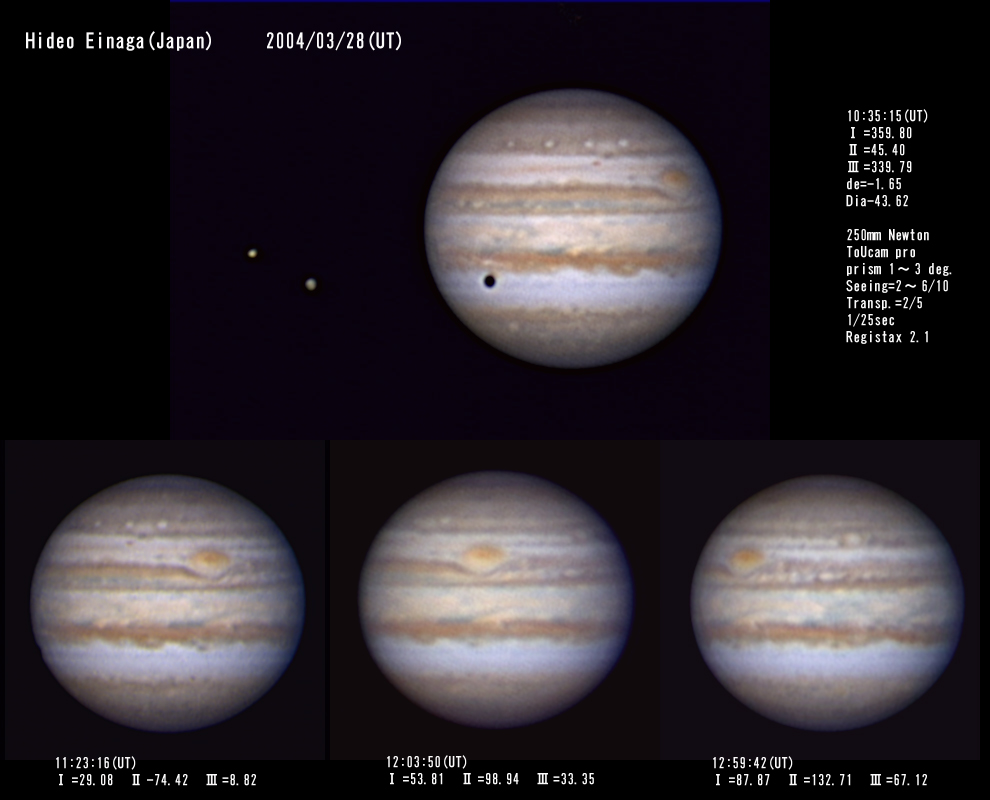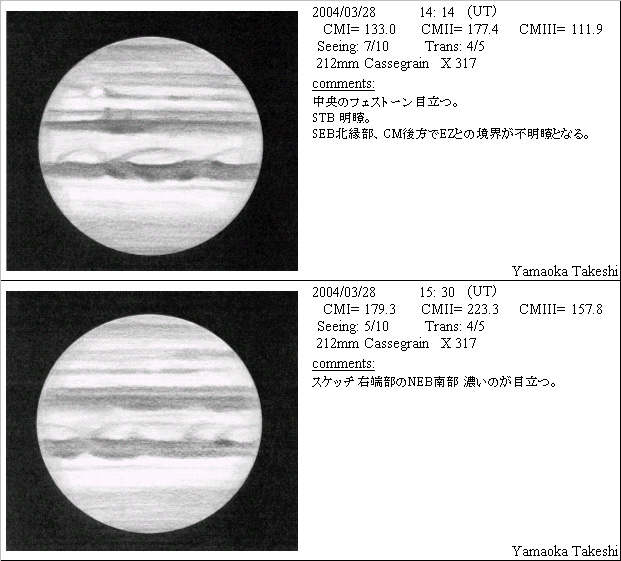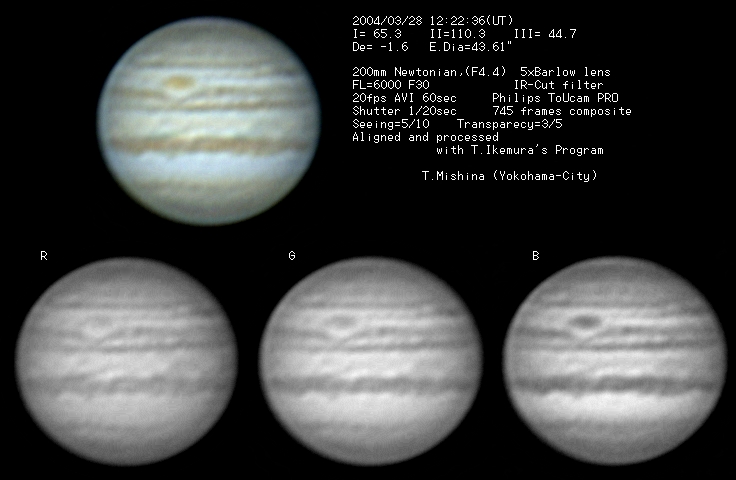|
Hideto Fukui (250mm Dall Kirkham, Philips ToUcam Pro)
|

[Hideto.Fukui (Sizuoka-Prefecture Japan)]
≪静岡県藤枝市 福井英人≫
|
Ikuo Takimoto (310mm Newtonian :ToUcam Pro )
|

2004/03/28 12:13:13(UT)
I=59.5 II=104.6 III=43.61
De=-1.6 E.Dia=43.61"
899 frames Stacked
Seeing:4/10 Trans:3/5
----------------------------------
2004/03/28 13:10:22(UT)
I=94.4 II=139.2 III=73.60
De=-1.6 E.Dia=43.61"
273 frames Stacked
Seeing:4/10 Trans:3/5
----------------------------------
2004/03/28 13:46:52(UT)
I=116.6 II=161.2 III=95.60
De=-1.6 E.Dia=43.61"
898 frames Stacked
Seeing:4/10 Trans:3/5
-----------------------------------------------------------
コメント:大赤斑の内部の南方では、オレンジ色が強いようだ。
シーイングが少し良いかなと思って粘るが、
悪くなってしまう。朝方まで辛抱できない。
[Ayauta-gun Kagawa-Prefecture Japan]
≪香川県 綾歌郡 瀧本郁夫≫
|
|
Toshihiko Ikemura (310mm Newton, Philips ToUcam PRO)
|

いつもこのくらい撮れるとうれしいのですが。
1枚目と2枚目は
1/30としてありますが設定上は1/25になっています。
3枚目からは露出1/33です。
1/33が なかなか調子が良いようです。
[T.Ikemura Nagoya Aichi JAPAN]
≪愛知県名古屋市 池村俊彦≫




|
|
Yuichi Iga (280mm SC, Philips ToUcam Pro)
|

2004/03/28 11:22:11(UT)
I= 28.4 II= 73.8 III= 7.2
De= -1.6 E.Dia=43.62"
280mm SCT, XP24mm(f/32), Philips ToUcam PRO, 1/33sec
90sec exposured, 250 frames stacked, No IR-cut filter, Registax
Seeing:4/10 Transp.:3/5
Y.Iga (Kyoto, JAPAN)
コメント:
・STBsの小暗斑はまだ健在である。
・STrZの大赤斑のかなり前方に白斑が存在する。
・大赤斑の前方のSEBnは以前ほどの青味はなくなっているようだ。
・NEB北縁はかなり複雑で、NTrZに白斑や暗斑がある。
≪京都市山科区 伊賀 祐一≫
|
|
Takashi Suzuki (180mmMakustov Casegrain, ToUcam Pro)
|

180mmMakustov Casse(f/1800mm)Abbe25mm(f/24)
Philips ToUcam Pro 1/25sec 20fps avi 90sec
1000frames stacked Seeing:6/10 Transp:3/5
[Takashi Suzuki (Hachiouji-City Tokyo Japan)]
≪東京都八王子市 鈴木 隆≫
|
|
Yukio Oshihoi (200mm Newtonian, Philips ToUcam Pro)
|

28日は夕方に木星面に三衛星の影が落ちる現象がありましたが、帰宅が遅くなり残念ながら見ることができませんでした。
自宅ベランダ観測所の木星観測可能時刻も刻々と早くなり、10時近くなると天井に半分隠されて口径10cm程度の解像
力になってしまいます。
[Yukio Oshihoi (Hirakata-City Oosaka-Prefecture Japan)]
≪大阪府 枚方市 忍穂井幸夫≫
|
|
Hideo Einaga (250mm Newton, Toucam Pro Webcam)
|

HIDEO EINAGA ≪兵庫県 加西 永長英夫≫
|
|
Takeshi-Yamaoka (212mm Cassegrain Drawing)
|

≪大阪府 豊中市 山岡武司≫
|
Takehiro Nonoguchi (105mm refractor:film)
|

10cm refractor (Pentax105SD) 、 Or7
Pentax LX、 露出2秒、 トレビ400c (ISO 400 リバーサル)
2004/03/28 21:10 (JST)
2004/03/28 12:10:00(UT)
I= 57.6 II=102.7 III= 37.1
De= -1.6 E.Dia=43.61"
seeing 5/10 trans 8/10
久しぶりに木星の写真をとりました。偶然にも
米山さんの撮像時刻と同じになりました。
大赤斑は、なかなか色が濃いです。
[Takehiro-Nonoguchi Takamatu-Kagawa-Japan ]
≪野々口猛浩 香川県高松市≫
|
|
SEiichi Kanno(250mm Newtonian, ToUcam Pro)
|
 この日は透明度はよくありませんがシーングは今期の中では
最もよい状態の日の1つで最後の1枚は今期のベストショット
です。
大赤斑の南部半分の赤みが強いのがよくわかります。また
大赤斑とBAとの間のSTBの北組織があるのがよくわかります。
SEBからNEBにかけて活動が活発な様子が確認できました。
≪山形県上山市 菅野清一≫




≪山形県上山市 菅野清一≫
|
Kazuhiko takimoto (Drawing: 150mm Newtonian)
|

------------------------------------------------------------------------------------------

≪和歌山県東牟婁郡 瀧本和彦≫
|
|
Kuniaki Horikawa(160mm Newtonian, Drawing & ToUcam PRO)
|

[Horikawa_J20040328-1100_drw.jpg]
2004/03/28 11h00m(UT)
I= 14.7 II= 60.2
Seeing=6-7/10 Transparency=3/5
・STBの暗斑は昨日の観測よりも濃く明瞭に見える
・NTrZの黒点はIII shadow
・今日からダイヤペークという紙になる、ニューケントよりは表面が荒れていない

[Horikawa_J20040328-1456_drw.jpg]
2004/03/28 14h56m(UT)
I=158.6 II=202.8
Seeing=7/10 Transparency=3/5
・EZsがCM左で白斑状に明るい、後方はSEBn edgeからprojectionが突き出てやや乱れている、EZs/SE
Bn disturbanceの主要部らしい
・EZnにはplume状の明部が見られる
・NEBは概ね二条

[Horikawa_J20040328-1602_drw.jpg]
2004/03/28 16h02m(UT)
I=198.8 II=242.7
Seeing=6/10 Transparency=2/5
・CM右でNEB内に白斑状の明部、新しいriftか?
・EZsはこの経度でも横長の白斑状の明部あり

[Horikawa_J20040328-1550_img.jpg]
2004/03/28 15h50m(UT)
I=191.5 II=235.4 De=-1.5 Dia=43.6
Seeing=6/10 Transparency=2/5
16cm Refl. x143
Philips ToUcam Pro 563 frames composite
≪神奈川県横浜市泉区 堀川邦昭≫
|
|
Carlos E. Hernandez (Drawing:9-inch (23-cm) F/13.5 Maksutov- Cassegrain)
|

Date (U.T.): Mach 28, 2004
Time (U.T.): 04:25
L1 134.0, L2 181.6, L3 114.9
Instrument: 9-inch (23-cm) F/13.5 Maksutov-Cassegrain
Magnification: 258x and 388x
Filters: None (IL)
Seeing (1-10): 5-6 (moments of 7), Antoniadi (I-V): III
Transparency (1-6): 3-4 (intermittent clouds)
Notes:
South Polar Region (SPR): Appeared dusky to dull (4-5/10) and mottled.
South South Temperate Zone (SSTZ): Appeared shaded (6/10) and thin.
South South Temperate Belt (SSTB): Appeared dusky (4/10) and thin.
South Temperate Zone (STZ): Appeared bright (7/10) and thin. Oval BE
appeared bright (7/10) and surrounded by a dark (3/10) collar towards
the preceding limb.
South Temperate Belt (STB): Appeared dark (3/10) and thin.
South Tropical Zone (STrZ): Appeared bright (7/10) without any other
detail visible within.
South Equatorial Belt (SEB): Appeared dark to dusky (3-4/10) with a
thin, bright (7/10) zone (SEBZ) separating the northern and southern
components.
Equatorial Zone (EZ): Appeared bright (7/10) with dark to dull (3-5/10)
festoon projections (loops) noted within.
North Equatorial Belt (NEB): Appeared dark to dusky (3-4/10) with
bright (7/10) condensations and rifts noted within it. Very dark to
dark (2-3/10) festoon bases were noted along the southern border
(NEBs). A very bright (8/10) bay was noted along the northern border
(NEBn) preceding the CM.
North Tropical Zone (NTrZ): Appears bright (7/10) without any detail
visible within.
North Polar Region (NPR): Appears dusky to dull (4-5/10) with thin
bands and zones noted within. This region also appears mottled.
The following Galilean satellites were observed from preceding to
following; Europa, Callisto, Ganymede and Io.
The best of luck to you and your family and in your own imaging of
Jupiter.
[[Carlos E. Hernandez South Florida U.S.A ]]
|
|
Bruno Daversin (305 and 600 mm cassegrain ToUcam Pro)
|

[Bruno Daversin Cherbourg, France]
|
Hubble Space Telescope(2900mm fl=5300mm)
|
South up image

Original jpg
At first glance, Jupiter looks like it has a mild case of the measles.
Five spots – one colored white, one blue, and three black – are
scattered across the upper half of the planet. Closer inspection by
NASA's Hubble Space Telescope reveals that these spots are actually a
rare alignment of three of Jupiter's largest moons – Io, Ganymede,
and Callisto – across the planet's face. In this image, the telltale
signatures of this alignment are the shadows [the three black circles]
cast by the moons. Io's shadow is located just above center and to the
left; Ganymede's on the planet's left edge; and Callisto's near the
right edge. Only two of the moons, however, are visible in this image.
Io is the white circle in the center of the image, and Ganymede is the
blue circle at upper right. Callisto is out of the image and to the right.
On Earth, we witness a solar eclipse when our Moon's shadow sweeps across
our planet's face as it passes in front of our Sun. Jupiter, however, has
four moons roughly the same size as Earth's Moon. The shadows of three of
them occasionally sweep simultaneously across Jupiter. The image was taken
March 28, 2004, with Hubble's Near Infrared Camera and Multi-Object
Spectrometer.
Seeing three shadows on Jupiter happens only about once or twice a decade.
Why is this triple eclipse so unique? Io, Ganymede, and Callisto orbit
Jupiter at different rates. Their shadows likewise cross Jupiter's face at
different rates. For example, the outermost moon Callisto orbits the slowest
of the three satellites. Callisto's shadow moves across the planet once for
every 20 shadow crossings of Io. Add the crossing rate of Ganymede's shadow
and the possibility of a triple eclipse becomes even more rare. Viewing the
triple shadows in 2004 was even more special, because two of the moons were
crossing Jupiter's face at the same time as the three shadows.
Jupiter appears in pastel colors in this photo because the observation was
taken in near-infrared light. Astronomers combined images taken in three
near-infrared wavelengths to make this color image. The photo shows sunlight
reflected from Jupiter's clouds. In the near infrared, methane gas in
Jupiter's atmosphere limits the penetration of sunlight, which causes clouds
to appear in different colors depending on their altitude. Studying clouds
in near-infrared light is very useful for scientists studying the layers of
clouds that make up Jupiter's atmosphere. Yellow colors indicate high clouds;
red colors lower clouds; and blue colors even lower clouds in Jupiter's
atmosphere. The green color near the poles comes from a thin haze very high
in the atmosphere. Ganymede's blue color comes from the absorption of water
ice on its surface at longer wavelengths. Io's white color is from light
reflected off bright sulfur compounds on the satellite's surface.
In viewing this rare alignment, astronomers also tested a new imaging
technique. To increase the sharpness of the near-infrared camera images,
astronomers speeded up Hubble's tracking system so that Jupiter traveled
through the telescope's field of view much faster than normal. This technique
allowed scientists to take rapid-fire snapshots of the planet and its moons.
They then combined the images into one single picture to show more details of
the planet and its moons.
[NASA/JPL/Space Science Institute]
 ALPO-Japan Latest ALPO-Japan Latest

 Jupiter Section Jupiter Section
| | | |




















